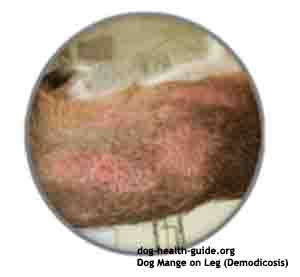Overview
Parasites that cause dog mange naturally live on dogs in low numbers. When the immune system isn't working properly, these mites are able to grow in number, causing clinical symptoms such as hair loss, skin lesions and pimples. Symptoms can appear in specific areas or spread across the body. The immune system could be negatively affected by a hereditary condition, hormonal disease, steroid based medications or chemotherapy.
If left untreated the condition can spread all over the dog's body. The disease is spread after contact with other infected dogs.

Source: Naturasil
Symptoms
These types of pimples are seen on the face in less than 4 places or in more than 5 areas on the body and paws. Other names for this condition are mange and scabies.
Other symptoms include intense itch. Crusts and hair loss often occurs on the edges of the ears, at at the elbows and on the stomach.
In chronic cases the skin can change color and thicken.
Diagnosis
A diagnosis of parasites is done by taking a skin scraping or biopsy and then examination under the microscope. The veterinarian will eliminate diseases with similar symptoms such as seasonal allergy (atopy), food allergy, and bacterial skin infection.
Treatment
If the pimples are in 1 area then follow one of the treatment options recommended for bacterial infection (above). If you see pimples in multiple areas then try an over the counter miticide such as Naturasil that mixes into your dog's shampoo or a dip containing amitraz, ivermectin or milbemycin. Many owners try the over the counter treatment first such as Naturasil for Pet Mange. If you don't see improvement then try a prescription approach.
Mite related diseases are very contagious. Be sure to wear gloves when handling your pet and clean your pets environment with a disinfectant such as Benzarid.
References:
Source: R.S. Mueller, Department of Clinical Sciences, College of Veterinary Medicine and Biomedical Sciences
Colorado State University
Researched by: Jeff Grill
